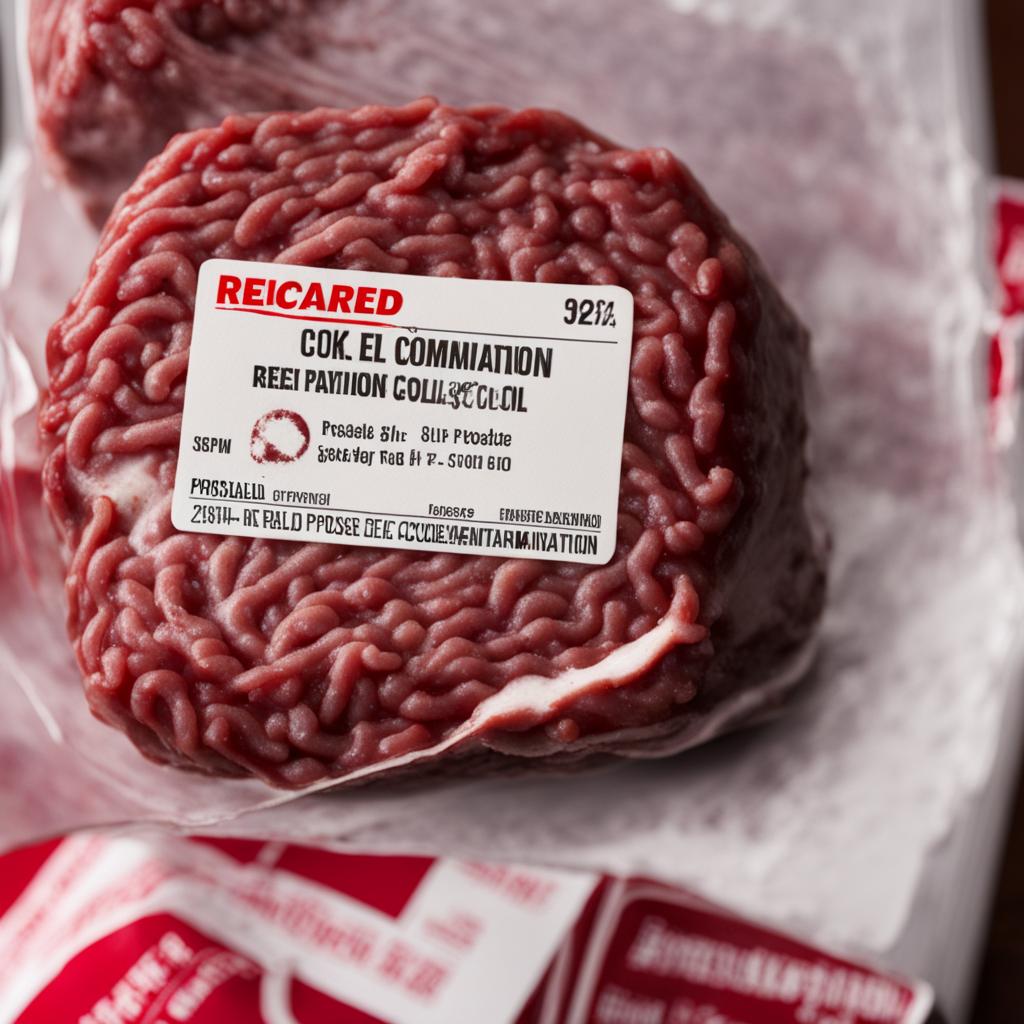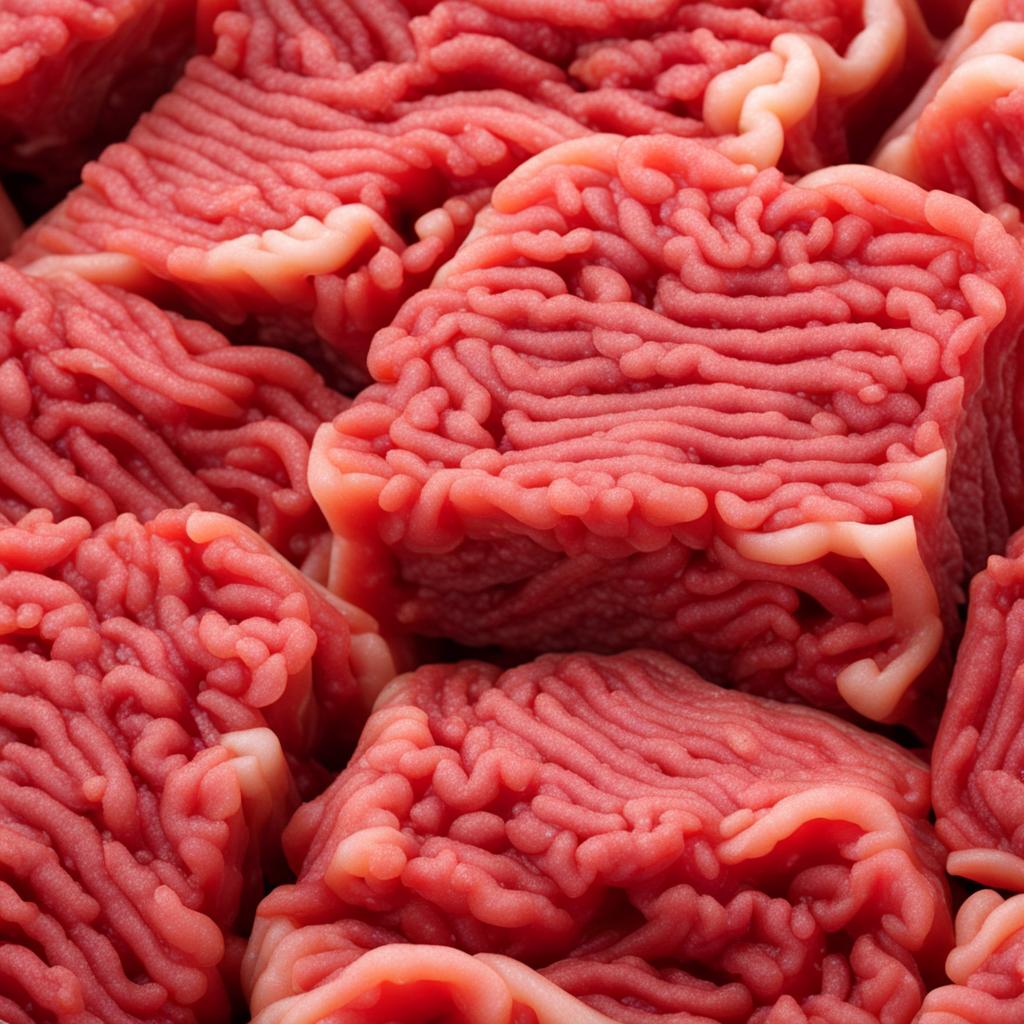Ground beef is a staple in many households, used to create delicious meals like burgers, tacos, and meatballs. But how can you tell if your ground beef has gone bad? In this article, I will guide you through the signs of spoiled ground beef, proper storage techniques, and the importance of cooking it to the right temperature. Safety should always be a top priority when handling meat, so let’s dive in and learn how to ensure the freshness of your ground beef.
Key Takeaways:
- Pay attention to the color, texture, and smell of ground beef to determine if it has spoiled.
- Store ground beef properly in the refrigerator or freezer to maintain its freshness.
- Cook ground beef to an internal temperature of 160°F (71°C) to prevent foodborne illnesses.
- Grey ground beef can be safe to eat if it doesn’t have a slimy texture or an off odor.
- Always follow the sell-by and use-by dates to ensure the safety of ground beef.
Signs of Spoilage in Ground Beef
When it comes to ground beef, freshness is key. To ensure you’re cooking with safe and high-quality meat, it’s important to know the signs of spoilage. Here are the key indicators to look out for:
- Changes in color: Fresh ground beef is typically bright red in color. If you notice any grey or greenish hues, it’s a clear sign that the meat has started to spoil.
- Texture: Properly stored ground beef should feel firm and crumbly. However, if it becomes slimy or sticky to the touch, it’s a strong indication that bacteria has begun to grow.
- Odor: Fresh ground beef should have a slight, almost sweet smell. If you detect any sour or unpleasant odors, it’s a sign that the meat has gone bad and should be discarded.
Remember, these signs of spoilage are not to be taken lightly. Consuming spoiled ground beef can lead to foodborne illnesses and pose health risks. Therefore, it’s important to trust your senses and err on the side of caution when determining if ground beef is still safe to eat.
To further illustrate the signs of spoilage, here is a table summarizing the visual indicators:
| Signs of Spoilage | Description |
|---|---|
| Changes in color | Grey or greenish hues |
| Texture | Slime or stickiness |
| Odor | Sour or unpleasant smell |
Remember, trust your senses when it comes to determining the freshness of ground beef. By being aware of these signs of spoilage, you can ensure that you’re cooking with safe and delicious meat.
Proper Storage of Ground Beef
When it comes to ground beef, proper storage is essential to maintain its freshness and ensure its safe consumption. Whether you need to store raw ground beef or leftovers from a cooked meal, following the right storage methods is crucial. Let’s take a look at some tips for properly storing ground beef in the refrigerator and freezer.
Refrigerator Storage
Raw ground beef can be stored in the refrigerator for 1-2 days. To ensure its freshness during this time, it’s important to keep it well-sealed in its original packaging or in an airtight container. This helps prevent any cross-contamination with other foods and minimizes the risk of bacteria growth. If you need to store ground beef for longer, it’s best to freeze it.
Freezer Storage
If you don’t plan to use ground beef right away, you can store it in the freezer for future use. To freeze ground beef, divide it into portion-sized packages and wrap each tightly in aluminum foil or place them in freezer bags. This helps prevent freezer burn and maintains the quality of the meat. Ground beef can be frozen for up to 4 months, but it’s always best to label each package with the date to keep track of its shelf life.
| Storage Method | Shelf Life |
|---|---|
| Refrigerator | 1-2 days |
| Freezer | Up to 4 months |
By properly storing ground beef, you can ensure its freshness and safety for consumption. Remember to always check for any signs of spoilage before using it, even if it has been stored correctly. If at any point the ground beef develops an off odor, turns green or grey, or feels slimy, it’s best to discard it to avoid any potential foodborne illnesses.
Cooking Ground Beef to the Right Temperature
When it comes to cooking ground beef, ensuring that it reaches the right temperature is crucial for food safety. Undercooked ground beef can harbor harmful bacteria that can cause foodborne illnesses. To protect yourself and your family, it’s important to follow proper cooking guidelines.
The recommended internal temperature for cooked ground beef is 160°F (71°C). This temperature is considered safe as it kills any potential pathogens, such as E. coli or Salmonella. Using a meat thermometer is the most accurate way to determine if the ground beef has reached the appropriate temperature. Insert the thermometer into the thickest part of the meat, avoiding any bones or fat.
By cooking ground beef to the right temperature, you can significantly reduce the risk of foodborne illnesses. It’s important to note that the color of the meat is not a reliable indicator of doneness. Even if ground beef appears brown in the center, it may not have reached the recommended internal temperature. Using a meat thermometer ensures that you have cooked the ground beef to a safe level.
| Ground Beef Doneness | Internal Temperature |
|---|---|
| Medium-Rare | 145°F (63°C) |
| Medium | 160°F (71°C) |
| Well-Done | 165°F (74°C) |
Always remember that cooking ground beef to the right temperature is essential for food safety. Don’t rely on visual cues alone; use a meat thermometer to ensure thorough cooking. By taking this simple step, you can enjoy delicious and safe ground beef dishes.
Is Grey Ground Beef Safe to Eat?
When it comes to ground beef, the color can often be an indicator of its freshness. But what does it mean when ground beef turns grey? Is it still safe to eat? The answer is, it depends.
While grey ground beef may not look as appetizing as its fresh pink counterpart, it doesn’t necessarily mean it is unsafe to consume. The change in color occurs due to oxidation, a natural process that happens when meat is exposed to air. However, it’s important to consider other factors before making a decision.
One key aspect to consider is the texture of the grey ground beef. If it feels slimy or has a sticky consistency, this could be a sign of spoilage and it is best to discard it. Additionally, if the grey ground beef has an off odor or smells sour, it is also a clear indication that it has gone bad. Trust your senses when evaluating the safety of grey ground beef.
It is always better to err on the side of caution when it comes to food safety. If you have any doubts about the quality or safety of grey ground beef, it is best to discard it and opt for fresh meat. Proper storage, handling, and cooking techniques are essential for minimizing the risk of foodborne illnesses. Remember, your health and well-being are worth the extra caution.
Table: Guidelines for Evaluating Grey Ground Beef
| Factors to Consider | Action |
|---|---|
| Texture: slimy or sticky | Discard |
| Odor: off or sour | Discard |
| Color: grey | Safe to eat if texture and odor are normal |
Remember, when in doubt, it is always better to prioritize your health and safety. Trust your senses and follow proper food handling practices to ensure a positive dining experience.
Ground Beef Sell-By Date and Use-By Date
When it comes to ground beef, understanding the sell-by date and use-by date is crucial for ensuring its freshness and safety. Let’s take a closer look at what these dates mean and how they can guide us in our decision-making process.
The sell-by date on a package of ground beef indicates the date by which it should be sold to the consumer. It is a guideline for retailers to ensure that the meat is still fresh and of high quality when purchased. However, it is important to note that the sell-by date is not an expiration date. Ground beef can still be consumed for 1-2 days after the sell-by date, as long as it has been stored properly in the refrigerator.
The use-by date, on the other hand, is the date by which the manufacturer recommends using the ground beef for the best quality and taste. Beyond this date, the meat may start to deteriorate in terms of texture, flavor, and overall quality. It is generally advised not to cook ground beef that is more than 3 days past its use-by date.
| Sell-By Date: | Guideline for retailers to sell ground beef |
|---|---|
| Use-By Date: | Recommended date for best quality and taste |
| Ground Beef After Sell-By Date: | Can still be consumed within 1-2 days if stored properly |
| Ground Beef After Use-By Date: | Not recommended for consumption |
It is important to remember that the sell-by and use-by dates are not set in stone. Factors such as storage conditions and handling practices can affect the quality and safety of ground beef. Always use your senses – smell, sight, and touch – to evaluate the freshness of the meat. If the ground beef has an off odor, unusual appearance, or slimy texture, it is best to err on the side of caution and discard it.
By paying attention to the sell-by and use-by dates, as well as using your sensory judgment, you can confidently enjoy ground beef that is both delicious and safe.
Thawing and Refreezing Ground Beef
Thawing and refreezing ground beef requires special attention to ensure food safety. Improper handling of thawed ground beef can increase the risk of bacterial growth and foodborne illnesses. Here are some guidelines to follow when thawing and refreezing ground beef:
Thawing Ground Beef
When thawing ground beef, it is important to do so in a safe manner. The best method is to place the frozen ground beef in the refrigerator and allow it to thaw slowly over a period of 24 to 48 hours. This ensures that the ground beef stays at a safe temperature, preventing the growth of harmful bacteria.
Alternatively, if you need to thaw ground beef quickly, you can use the microwave’s defrost setting or submerge the sealed package in cold water. However, once thawed using these methods, the ground beef should be cooked immediately and should not be refrozen.
Refreezing Ground Beef
Ground beef that has been thawed in the refrigerator can be refrozen if it is still within its safe consumption period. However, if the ground beef has been thawed using other methods such as running it under cold water or using the microwave, it should not be refrozen as it may have entered the temperature danger zone where bacteria can rapidly multiply.
It is important to note that refreezing ground beef may affect its quality, as the texture and juiciness may be altered. If you plan to refreeze ground beef, it is advisable to cook it first before refreezing to maintain its taste and texture.
By following these guidelines, you can safely thaw and refreeze ground beef, minimizing the risk of foodborne illnesses and ensuring the quality of the meat.
| Thawing Method | Safe to Refreeze? |
|---|---|
| Refrigerator Thawing | Yes, if within safe consumption period |
| Microwave Defrosting | No |
| Cold Water Thawing | No |
Leaving Cooked Ground Beef Out at Room Temperature
When it comes to food safety, proper handling of cooked ground beef is crucial. Leaving cooked ground beef out at room temperature for too long can increase the risk of bacterial growth and foodborne illnesses. It is important to follow specific guidelines to ensure the safety and quality of your cooked ground beef.
According to food safety experts, cooked ground beef should not be left out at room temperature for more than 2 hours. This timeframe decreases to 1 hour if the room temperature exceeds 90°F (32.2°C). Bacteria such as Salmonella and E. coli can multiply rapidly in the “danger zone” temperature range of 40°F (4.4°C) to 140°F (60°C). Therefore, it is essential to store cooked ground beef properly to prevent bacterial growth and reduce the risk of foodborne illnesses.
After cooking ground beef, it is recommended to immediately refrigerate it to maintain its freshness and safety. Once cooled, store the cooked ground beef in an airtight container in the refrigerator at a temperature below 40°F (4.4°C). If you plan on consuming the cooked ground beef later, make sure to reheat it to an internal temperature of 165°F (73.9°C) before serving. This will help kill any bacteria that may have grown during storage.
Table: Guidelines for Leaving Cooked Ground Beef Out at Room Temperature
| Situation | Time Limit |
|---|---|
| Room Temperature below 90°F (32.2°C) | 2 hours |
| Room Temperature above 90°F (32.2°C) | 1 hour |
Ground Beef Recalls and Safety Guidelines
In recent years, there have been several ground beef recalls due to concerns over food safety. These recalls are an important reminder of the potential risks associated with consuming contaminated ground beef. To ensure the safety of consumers, it is crucial to follow safety guidelines and take necessary precautions when handling and consuming ground beef.
Ground beef recalls are typically initiated when there is evidence of contamination with harmful bacteria, such as E. coli or Salmonella. These bacteria can cause serious foodborne illnesses, leading to symptoms like diarrhea, vomiting, and abdominal pain. In some severe cases, these illnesses can even result in hospitalization or death.
To protect yourself and your family, it is important to stay informed about ground beef recalls and follow the instructions provided by the United States Department of Agriculture (USDA) or the manufacturer. If you have purchased ground beef that is subject to a recall, it is crucial to dispose of the product or return it to the place of purchase for a refund. Avoid consuming recalled ground beef, even if it has been cooked, as cooking may not fully eliminate the risk of illness.
| Recall Date | Brand | Reason for Recall |
|---|---|---|
| June 2020 | ABC Meat Company | E. coli contamination |
| August 2019 | XYZ Farms | Salmonella contamination |
| October 2018 | 123 Beef Products | Undeclared allergens |
Ground Beef Safety Guidelines
- Always purchase ground beef from reputable sources and check for any recalls before buying.
- Store ground beef properly in the refrigerator or freezer to maintain its freshness and prevent bacterial growth.
- Cook ground beef to the recommended internal temperature of 160°F (71°C) to ensure that all harmful bacteria are killed.
- Prevent cross-contamination by keeping raw ground beef separate from other foods, especially ready-to-eat items.
- Thoroughly clean and sanitize any utensils, cutting boards, or surfaces that come into contact with raw ground beef.
- Wash your hands with soap and water for at least 20 seconds before and after handling ground beef.
- If in doubt about the safety of your ground beef, it is best to err on the side of caution and discard it.
By following these safety guidelines and staying informed about ground beef recalls, you can minimize the risk of foodborne illnesses and enjoy ground beef safely.

Importance of Farmers in Ensuring Beef Safety
When it comes to ensuring the safety of beef, farmers play a vital role in the process. They are responsible for implementing strict food safety regulations, adhering to proper handling and testing procedures, and investing in research and development. By doing so, farmers contribute to the overall quality and safety of beef products that reach consumers’ tables.
One of the key responsibilities of farmers is to ensure that their livestock is raised in a safe and healthy environment. This includes maintaining clean and sanitary conditions in their farms, providing appropriate nutrition to the animals, and following strict guidelines for the use of antibiotics and other medications. By prioritizing the well-being of their animals, farmers can help minimize the risk of diseases and contamination that can affect the safety of beef.
In addition to upholding food safety regulations, farmers also collaborate closely with inspection agencies to ensure that their products meet the highest quality standards. Regular inspections and audits are conducted to assess the cleanliness and safety of the farming operations. Farmers work closely with these agencies, providing them with the necessary documentation and records to demonstrate compliance with food safety guidelines.
Furthermore, farmers support the safety of beef by collaborating with processing facilities. These facilities also adhere to strict food safety practices and are subject to rigorous inspections by regulatory bodies such as the USDA. By partnering with reliable processing facilities, farmers can ensure that their beef products are processed and handled under safe and hygienic conditions. This partnership between farmers and processing facilities is crucial in maintaining the safety and integrity of beef throughout the supply chain.
In conclusion, farmers play a significant role in ensuring the safety of beef by following food safety regulations, collaborating with inspection agencies, and working alongside processing facilities. Their commitment to maintaining high standards of safety and quality is crucial in providing consumers with safe and wholesome beef products.
Ground Beef and Foodborne Illnesses
I want to shed light on the connection between ground beef and foodborne illnesses. Ground beef is a popular ingredient in many dishes, but it can also pose risks if not handled and cooked properly. This section will explore the presence of spoilage bacteria and pathogenic bacteria in ground beef, and how they can lead to foodborne illnesses if consumed.
Understanding Spoilage Bacteria
Ground beef is susceptible to spoilage caused by bacteria. Spoilage bacteria, also known as deteriorative bacteria, can grow on the meat when it is not preserved correctly. These bacteria can alter the appearance, texture, and smell of the ground beef, indicating that it is no longer safe to eat. Common spoilage bacteria include Pseudomonas and Acinetobacter species.
The Dangers of Pathogenic Bacteria
In addition to spoilage bacteria, ground beef can also harbor pathogenic bacteria that cause foodborne illnesses. Pathogenic bacteria, such as Escherichia coli (E.coli) and Salmonella, can contaminate ground beef during the slaughtering and processing stages. Consuming ground beef contaminated with these bacteria can lead to symptoms like nausea, vomiting, diarrhea, and more severe health complications.
Food safety tip: It is crucial to handle and cook ground beef properly to reduce the risk of foodborne illnesses. Always follow recommended cooking temperatures and hygiene practices to ensure the safety of your food.
Ensuring the safety of ground beef begins with proper storage, handling, and cooking techniques. It is essential to purchase ground beef from trusted sources and check for proper packaging and relevant labels. Storing ground beef at the correct temperature in the refrigerator and cooking it to the recommended internal temperature can help kill any harmful bacteria present. By understanding the risks and taking necessary precautions, we can enjoy ground beef safely and minimize the chances of foodborne illnesses.
Table: Comparison of Spoilage and Pathogenic Bacteria in Ground Beef
| Bacteria Type | Characteristics | Health Risks |
|---|---|---|
| Spoilage Bacteria | Causes changes in appearance, texture, and smell of ground beef | No immediate health risks, but indicates the meat is no longer fresh |
| Pathogenic Bacteria | May not cause noticeable changes, but can lead to foodborne illnesses | Can cause symptoms like diarrhea, vomiting, and more severe complications |

It is important to educate ourselves and others about the risks associated with ground beef and foodborne illnesses. By practicing safe food handling, storage, and cooking techniques, we can reduce the chances of contamination and enjoy ground beef without compromising our health.
The Role of Color, Texture, and Smell in Evaluating Ground Beef
Color, texture, and smell are key indicators of the freshness and quality of ground beef. By paying attention to these factors, you can determine whether the ground beef is still suitable for consumption or if it has spoiled. This section will explore the significance of color, texture, and smell when evaluating ground beef.
The Importance of Color
When it comes to ground beef, the ideal color is pink. Fresh ground beef that has been properly stored will have a vibrant pink hue. However, if the color of the ground beef starts to turn grey or green, it is a clear sign of spoilage. These changes in color indicate that bacteria have started to grow, and the ground beef should not be consumed.
Assessing Texture
The texture of ground beef can also provide valuable insights into its freshness. Fresh ground beef should have a firm and crumbly texture. If the ground beef feels slimy or sticky, it is a clear indication of spoilage. The sliminess is caused by the growth of bacteria, and consuming such meat can pose a serious health risk.
The Role of Smell
Smell is another important factor to consider when evaluating ground beef. Fresh ground beef will have a mild, faint odor. However, if the ground beef emits a strong, unpleasant smell, it is a clear indication of spoilage. The foul odor is caused by the presence of bacteria, and the ground beef should not be consumed.
In conclusion, color, texture, and smell play vital roles in determining the freshness and safety of ground beef. Paying attention to these factors can help you make informed decisions about whether to consume or discard the ground beef. It is always better to be cautious and prioritize food safety to avoid any potential health risks.
Ground Beef Expiration Date and Sell-By Date
When it comes to ground beef, it is crucial to pay attention to both the expiration date and the sell-by date. These dates provide valuable information about the freshness and safety of the ground beef. It is recommended not to consume ground beef past its expiration date, as it may have started to spoil and could pose a risk to your health.
The sell-by date, on the other hand, is a guideline for retailers and indicates how long the ground beef should be displayed for sale. Ground beef can still be consumed for 1-2 days after the sell-by date if it has been stored properly in the refrigerator. However, it is important to carefully inspect the ground beef for any signs of spoilage before consuming it.
By adhering to these dates, you can ensure that you are consuming fresh and safe ground beef. It is always better to err on the side of caution and discard ground beef that is past its expiration date or shows signs of spoilage, such as a foul odor or slimy texture. Your health and safety should always be the top priority when it comes to consuming food.
| Expiration Date | Sell-By Date |
|---|---|
| Indicates when ground beef is likely to start going bad. | Guideline for retailers on how long to display ground beef for sale. |
| Recommended not to consume ground beef past this date. | Ground beef can still be consumed for 1-2 days after this date, if stored properly. |
| Check for any signs of spoilage before consuming. | Inspect ground beef carefully for signs of spoilage. |
Safe Handling and Preparing Ground Beef
When it comes to ground beef, safe handling and preparation practices are crucial to ensure food safety. By following these guidelines, you can minimize the risk of foodborne illnesses and enjoy your ground beef dishes with peace of mind.
Proper Handwashing
One of the first steps in safe handling is to wash your hands thoroughly before and after handling raw ground beef. Use warm water and soap for at least 20 seconds to effectively remove bacteria. This helps prevent cross-contamination with other foods and reduces the spread of harmful pathogens.
Separate Raw Meat from Other Foods
It’s important to keep raw ground beef separate from other foods, especially those that will be consumed raw, such as salads or fruits. Cross-contamination can occur when juices from raw meat come into contact with ready-to-eat foods, leading to the transfer of harmful bacteria. Use separate cutting boards, utensils, and plates for raw and cooked foods to prevent contamination.
Cooking to the Right Temperature
Cooking ground beef to the right temperature is essential for food safety. The internal temperature should reach 160°F (71°C) to ensure that any bacteria present in the meat are destroyed. Using a meat thermometer is the most accurate way to determine if the ground beef is cooked to a safe temperature throughout.
Storage Tips
When storing ground beef, it is important to keep it refrigerated at a temperature below 40°F (4°C). If you’re not going to use it right away, it can be safely stored in the refrigerator for 1-2 days. To extend its shelf life, you can also freeze ground beef. Make sure to wrap it tightly in plastic wrap or place it in a freezer bag to prevent freezer burn. Frozen ground beef can be stored for up to 4 months.
By following these safe handling and preparation practices, you can enjoy ground beef dishes without compromising your health. Remember to always prioritize food safety and make informed choices when it comes to handling and cooking ground beef.
Ground Beef Storage and Freezing Tips
Proper storage and freezing techniques are crucial for maintaining the quality and freshness of ground beef. Whether you’re storing raw ground beef in the refrigerator or freezing it for future use, following these tips will help prevent spoilage and freezer burn.
Storing Ground Beef
When storing ground beef in the refrigerator, it’s important to keep it at a temperature below 40°F (4°C) to slow down the growth of bacteria. To ensure proper storage:
- Keep ground beef in its original packaging if unopened. If opened, transfer it to an airtight container or resealable plastic bag.
- Place the ground beef on a plate or tray to catch any juices that may leak.
- Store ground beef on the lowest shelf of the refrigerator to prevent cross-contamination with other foods.
- Consume raw ground beef within 1-2 days of purchase for optimal freshness.
If you’re not planning to use the ground beef within a few days, freezing is a great option to prolong its shelf life.
Freezing Ground Beef
When freezing ground beef, proper packaging is essential to prevent freezer burn and maintain its quality. Here’s how to freeze ground beef:
- Divide the ground beef into portions that you’re likely to use in one cooking session.
- Wrap each portion tightly in plastic wrap or aluminum foil to prevent freezer burn.
- Alternatively, place the portions in resealable freezer bags, removing as much air as possible before sealing.
- Label each package with the date of freezing to keep track of its shelf life.
- Store the wrapped or bagged ground beef in the freezer at a temperature of 0°F (-18°C) or below.
Frozen ground beef can typically be kept for up to 4 months without a significant loss in quality. However, it’s best to consume it sooner rather than later for the best taste and texture.
By following these storage and freezing tips, you can ensure that your ground beef remains safe to eat and maintains its quality for longer periods of time.
Conclusion
In conclusion, ensuring the safety of ground beef is of utmost importance to avoid the risk of foodborne illnesses. By following proper handling, storage, and cooking techniques, individuals can enjoy ground beef without compromising their health.
Recognizing the signs of spoilage, such as changes in color, texture, and smell, is crucial in determining whether ground beef is still safe to consume. Additionally, paying attention to expiration dates and following food safety guidelines can help prevent the consumption of spoiled or contaminated meat.
Remember, properly storing ground beef in the refrigerator or freezer and cooking it to the right temperature are key steps in maintaining its freshness and eliminating harmful bacteria. By practicing good food safety habits, you can protect yourself and your family from the risks of foodborne illnesses associated with ground beef.
In summary, prioritize ground beef safety by being mindful of the signs of spoilage, adhering to expiration dates, and implementing safe handling and cooking practices. By doing so, you can enjoy delicious and safe ground beef meals without compromising your well-being.
FAQ
How can I tell if ground beef is bad?
Signs of spoilage in ground beef include changes in color, such as turning grey or green, and a slimy texture. It may also have a sour or unpleasant odor. These are indications that the ground beef is no longer fresh and should be discarded.
How should I store ground beef?
Ground beef should be stored in the refrigerator to keep it fresh for as long as possible. If it cannot be consumed or cooked immediately, it can be frozen for future use. Raw ground beef can be stored in the refrigerator for 1-2 days, while cooked ground beef can last for 3-4 days. When freezing ground beef, it is recommended to divide it into portions and wrap it in aluminum foil or place it in a freezer bag to prevent freezer burn. Ground beef can be frozen for up to 4 months.
What temperature should I cook ground beef to?
It is important to cook ground beef to an internal temperature of 160°F (71°C) to ensure that any harmful bacteria are killed. Undercooked ground beef can lead to foodborne illnesses such as E. coli or Salmonella. Using a meat thermometer is the best way to determine if ground beef has reached the appropriate temperature.
Is it safe to eat grey ground beef?
While it is generally safe to eat ground beef that has turned grey, it is still important to consider other factors such as smell and texture. If the grey ground beef has a slimy texture or an off odor, it is best to discard it.
How long can ground beef be stored past its sell-by date?
It is recommended not to cook ground beef that is more than 3 days past its sell-by date. However, ground beef can still be consumed within 1-2 days past its use-by date if it has been stored properly in the refrigerator.
Can I refreeze ground beef that has been thawed?
Ground beef can be refrozen if it has been thawed in the refrigerator. However, if it has been thawed in water or in the microwave, it should not be refrozen as it may no longer be safe to eat.
How long can cooked ground beef be left out at room temperature?
Cooked ground beef should not be left out at room temperature for more than 2 hours (or 1 hour if the temperature is above 90°F/32.2°C). After this time, bacteria can start to grow, increasing the risk of foodborne illnesses.
What should I do in the event of a ground beef recall?
In cases of ground beef recalls, it is important to follow the instructions provided by the USDA and dispose of or return the product to the place of purchase. Following safety guidelines, such as proper storage, cooking, and handling practices, can help prevent foodborne illnesses associated with ground beef.
What role do farmers play in ensuring beef safety?
Farmers play a crucial role in ensuring the safety of beef by investing in research, adhering to food safety regulations, and implementing proper handling and testing processes. Processing facilities also focus on food safety by complying with USDA inspections and investing in safety measures.
Why is ground beef a common source of foodborne illnesses?
Ground beef is a common source of foodborne illnesses due to the presence of both spoilage bacteria and pathogenic bacteria. Spoilage bacteria can cause the meat to lose quality and develop a bad odor and taste, while pathogenic bacteria can lead to food poisoning if consumed.
How do color, texture, and smell indicate the freshness of ground beef?
Color, texture, and smell are important factors in determining the freshness of ground beef. Fresh ground beef should have a pink color, a firm and crumbly texture, and a faint smell. Any changes in these characteristics can indicate spoilage and the need to discard the ground beef.
What do the expiration date and sell-by date on ground beef mean?
The expiration date on the label of ground beef indicates when it is likely to start going bad. It is recommended not to consume ground beef past its expiration date. The sell-by date is a guideline for retailers and ground beef can still be consumed for 1-2 days after the sell-by date if stored properly.
How can I handle and prepare ground beef safely?
Safe handling and preparation of ground beef include washing hands before and after handling, keeping raw meat separate from other foods to prevent cross-contamination, and cooking ground beef to the right temperature. These practices help minimize the risk of foodborne illnesses.
What are some tips for storing and freezing ground beef?
Ground beef should be stored in the refrigerator to maintain its freshness. If not consumed immediately, it can be frozen for future use. Proper wrapping and labeling can help prevent freezer burn and maintain the quality of frozen ground beef.
Source Links
- https://health.clevelandclinic.org/how-to-tell-if-ground-beef-is-bad/
- https://www.foodnetwork.com/healthyeats/healthy-tips/2019/10/how-to-tell-if-your-ground-beef-is-bad
- https://www.wikihow.com/Tell-if-Ground-Beef-Has-Gone-Bad
Related Recipes:
 How to Tell if Ground Pork is Bad: Health Guidelines
How to Tell if Ground Pork is Bad: Health Guidelines
 How Long Can Cooked Chicken Sit Out? Safety Tips.
How Long Can Cooked Chicken Sit Out? Safety Tips.
 How to Store Meat for Freshness and Safety
How to Store Meat for Freshness and Safety
 How Long Can Pizza Sit Out? Safety and Storage Tips
How Long Can Pizza Sit Out? Safety and Storage Tips
 How Long Can Yogurt Sit Out? Guidelines and Safety
How Long Can Yogurt Sit Out? Guidelines and Safety
 Beef Stew Shelf Life: How Long Does It Last in the Fridge?
Beef Stew Shelf Life: How Long Does It Last in the Fridge?
 How to Tell if Ground Turkey is Bad: Quality Check
How to Tell if Ground Turkey is Bad: Quality Check
 How to Tell if Chicken is Bad: Identifying Spoilage
How to Tell if Chicken is Bad: Identifying Spoilage








